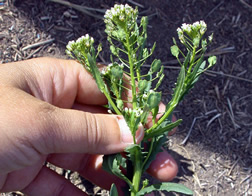 While it might have been something that farmers have tried to keep out of their fields, stinkweed could prove to be a successful product for those growing feedstocks for biodiesel.
While it might have been something that farmers have tried to keep out of their fields, stinkweed could prove to be a successful product for those growing feedstocks for biodiesel.
This article in the Atlanta Journal Constitution says stinkweed… also known as field pennycress… might just be the ticket for those trying to find a non-food stock for the green fuel:
Past promises of cheap fuel grown on American soil have sometimes become, um, stuck in the weeds as prices for commodities such as corn and soybean oil rose. But a number of researchers believe that this winter weed with oily little seeds has an advantage in that it is not a food crop.
“Our intention is to create a crop that has a niche and does not displace anything else that is already growing,” said Steve Vaughn, a plant physiologist with the National Center for Agricultural Utilization Research in Peoria, Ill.
Soybeans, like corn, are a commodity in demand for food and fuel. Prices for soybean oil have more than doubled since 2005, giving the industry added incentive to experiment with other potential sources of fuel.
“The rise in commodity prices has really driven us to focus on other alternatives,” said John Fox, Innovation’s chief executive officer. Innovation relies primarily on animal fat to make biodiesel at its Newark, N.J. refinery.
The article goes on to point out that in addition to the non-food sources, researchers are also looking at increasing the yields of a more traditional feedstocks, such as soybeans.

